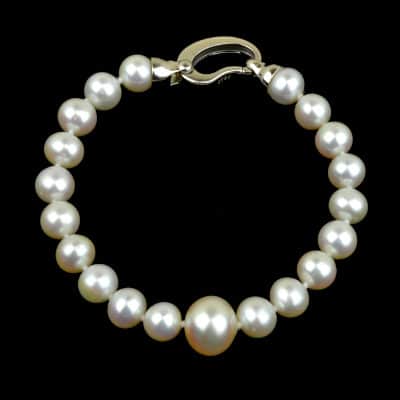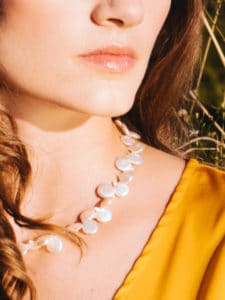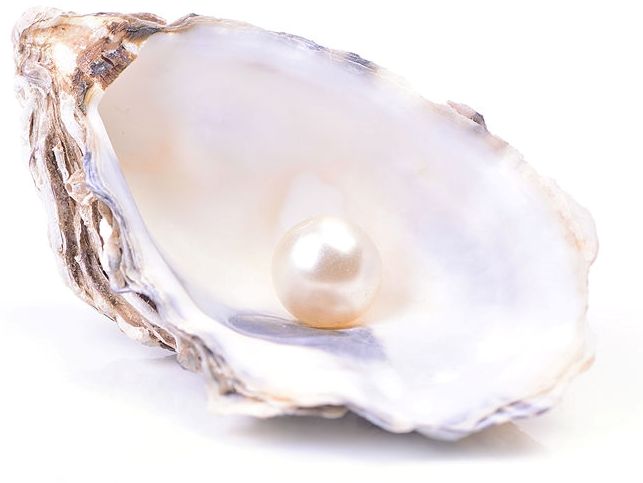
June’s birthstone, Pearl, has always held a special place in our culture from Steinbeck’s novel The Pearl to the iconic necklace worn by Audrey Hepburn in Breakfast at Tiffany’s. These unique gemstones have been worn and admired for centuries, probably since humans first started opening up mollusks. They are mentioned, of course, in the Bible, the Qur’an, and other ancient writings.
Pearl Is Iconic Like No Other
They’re our gift’s from the Mermaids, luxurious and sensual, with a radiant luster that glows when worn. Pearls flatter everyone!
If you’re a Pearl devotee, then you’ve seen the versatility that Pearls contribute to the jewelry world. They range in shapes from classic strands of round Pearls to bizarre-looking shapes that create phenomenal artistic designs.
In addition, their colors range through a rainbow of shades. Most of us are familiar with varieties of white, cream, golden, yellow, silver, and black. However, you’ll also find colored Pearls of gold, silver, green, blue, red, black, pink, peach, and purple. These can be natural or dyed.
The use of Pearls in jewelry is limited only by the imagination of jewelry designers. So, Pearls are used in bracelets, earrings, pins, brooches, rings, pendants, and of course, those strands or necklaces of every possible length.
At Copeland Jewelers, we love to show off Pearls. We’ll guide you on the quality and value of their many varieties. With Pearls in hand and a little bit of guidance, you will easily see how to pick out a good pearl.

Pearl Meanings
- Pearls manifest innocence, charity, and faith.
- It helps deepen your personal integrity and to focus your attention.
- In addition, they symbolize purity. Purity clears our body and mind for wisdom and spiritual guidance.
- Historically, Pearls have been used to treat digestive disorders, increase fertility and ease childbirth.
Pearl Formation
A Pearl is formed when a small irritant gets into the shell of a mollusk. To protect itself, the animal covers the irritant with layers of nacre (pronounced “NAY-kur”), composed largely of calcium carbonate. Valuable Pearls used in jewelry come only from certain types of oysters and mussels. Yet, almost any shelled mollusk can produce some kind of Pearl under the right circumstances. However, most of them have no luster or iridescence and may break down easily.
Natural vs. Cultured Pearls
Natural Pearls – At one time, all the Pearls in the world were natural pearls. Meaning, a Pearl formed around a natural irritant in the oyster or mollusk. Today, it’s very rare to find a natural Pearl but most are found off the coasts of Bahrain and Australia. Unsurprisingly, natural Pearls are very costly these days. Be aware, if you have your Great Grandmother’s strand of tiny pearls, they may be natural. If so, they may not look impressive, but could be worth a pretty penny in today’s market!
Cultured pearls – These make up the vast majority of Pearls on the market today. Purposely grown on Pearl farms, technicians implant a small irritant inside a mollusk to cause the formation of a Pearl. So easily done, culturing has made beautiful Pearls highly affordable. When shopping for Pearls or Pearl jewelry, assume you are looking at cultured Pearls unless specifically told otherwise. You may also come across imitation Pearls during the course of your shopping. These are not actually Pearls, but glass beads painted to look like Pearls. When you slide these imitations across the fronts of your teeth they will feel slick. Real Pearls feel rough.
Saltwater & Freshwater Pearls
Another important distinction in the world of Pearls is whether they originate in saltwater or freshwater.
Saltwater Pearls come from oysters. They’re cultured with a small, round bead, usually leading to a perfectly round or almost-round Pearl. There are many varieties of saltwater Pearls including those from Akoya oysters grown in China and Japan, South Sea Pearls from Australia, Indonesia, and the Philippines, and Tahitian Pearls, which come from many different islands in French Polynesia, Tahiti included.
Freshwater Pearls come from mussels grown in freshwater lakes, rivers, and ponds, predominately in China. However, some come from colder, more temperate areas, such as Scotland. These Pearls are usually begun with a piece of tissue rather than a tiny bead. This leads to a thicker coating of nacre. Each freshwater mussel can produce up to fifty Pearls in its lifetime. Whereas, each saltwater oyster is limited to a maximum of three. Consequently, freshwater Pearls are more abundant than saltwater Pearls.
Valuing June’s Birthstone
There are many qualities that determine the value of a Pearl: shape, size, surface, luster, and color.
These qualities are largely the result of the place in the world where the Pearls originate. But they can also be determined by the individual mollusk. Some factors can even be scientifically manipulated after Pearl is formed.
- Shape – Generally, the rounder a Pearl is, the more valuable it will be. But, other shapes, such as eggs, teardrops, half Pearls (formed directly against the mollusk’s shell), or even highly irregular forms are also prized for unique pieces.
- Size – As with many things, the larger a Pearl is, the higher it’s value.
- Surface – The surface of a Pearl can range from smooth to rough, with smooth surfaces being prized.
- Luster – Its luster (determined by the quality of its nacre) can range from very bright, to bright, to medium, to slightly dull, to dull. Naturally, the brighter the luster, the greater the value.
- Color – Most Pearls are generally whitish, although their specific tones can be pure white, cream, pinkish, bluish, or yellowish. Some Pearls, depending on their geographic and aquatic origin, can be brightly colored, including gold, silver, green, blue, red, black, pink, peach, and purple. Sometimes light-colored Pearls are dyed different colors. A Pearl with natural color will be more valuable than a dyed Pearl, and rare colors are more valuable than common ones. Some colors or tones of Pearls will look different against different skin tones or fabric colors. So, be sure to try Pearls on and see how they look on you before making a final decision.
Pearl Strand Lengths
There are six different length classifications for strands of Pearls:
- collar – rests flush against the neck
- choker – rests just above the collarbone
- princess – about eighteen inches in length
- matinee – twenty to twenty-four inches
- opera – thirty to thirty-six inches long
- rope – any strand longer than thirty-six inches
Taking Care of Your Pearls
Because Pearls are delicate, porous gemstones, they should only be cleaned with a very soft cloth. Pearls can actually dissolve in vinegar due to their makeup of calcium carbonate. Steam cleaning, ultrasonic cleaning, solvents, and chemicals can damage Pearls.
For home use, we recommend a good Pearl conditioner, like Hagerty Pearl Cleaner. This is the only time you should really dip your Pearl strands in any liquid. And, be sure to dry that strand completely. Otherwise, the silk will stretch that your Pearls are strung on.
In addition, stay away from tools with even the mildest amount of scrubbing power, including toothbrushes. Do not keep Pearls in plastic bags. Do not layer jewelry or other items on top of your Pearls.
If you’re looking for June’s birthstone, Pearl, stop by to view our wonderful selection! Our jewelry store in Austin is more than happy to answer any questions you may have about pearls and pearl jewelry!

